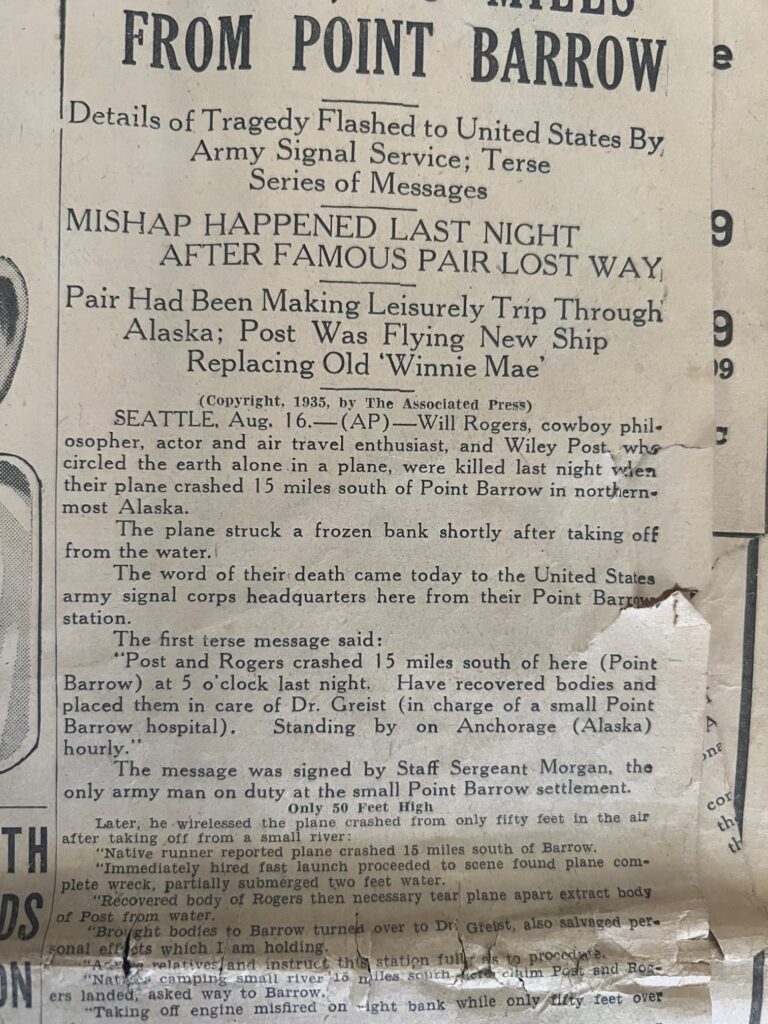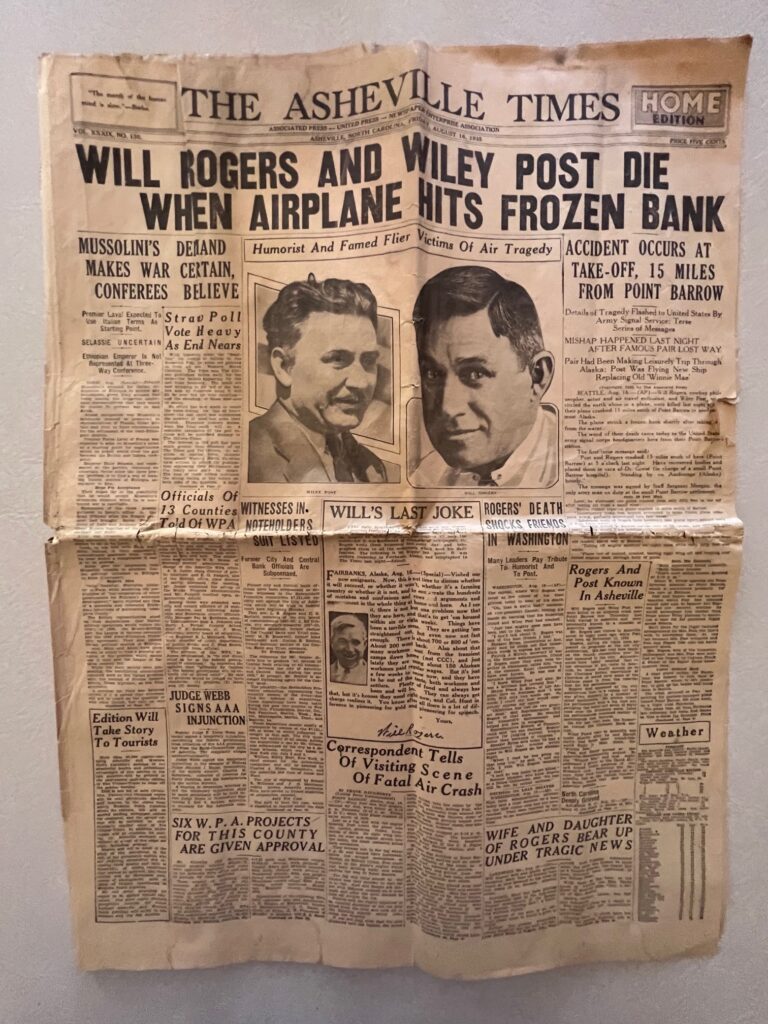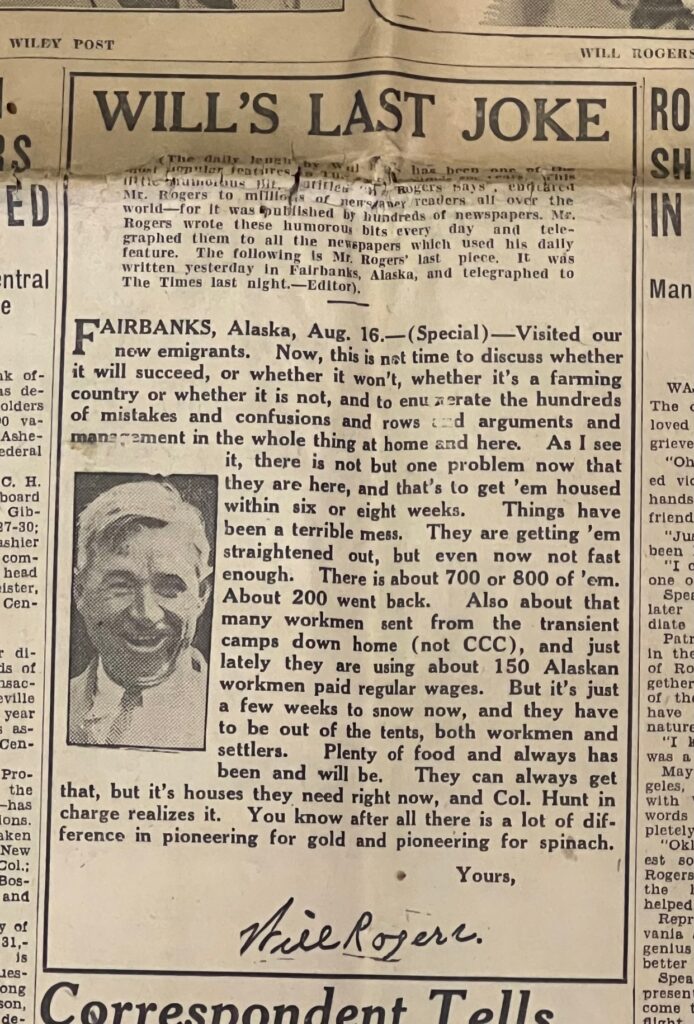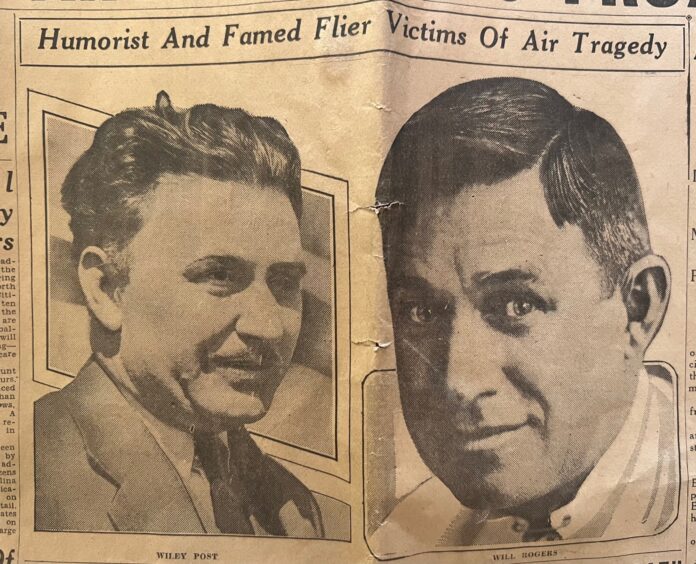By CARONE COBDEN
Last week, while visiting Sedona, a friend came by with an unexpected gift. He had stumbled upon a unique treasure during a recent outing to an estate sale and as he knew I was from Alaska, he thought it may be of interest.
Buried among the many offerings that weekend, he’d discovered a well-preserved newspaper, yellow and time-worn, carefully sealed in plastic. It was an August 16, 1935, edition of North Carolina’s Asheville Times daily newspaper. Its front page announced in large bold type: “Will Rogers and Wiley Post Die When Airplane Hits Frozen Bank, Accident Occurs at Take-Off, 15 Miles from Point Barrow.”
That tragic event took place 88 years ago this week.

I decided to revisit the contents of the newspaper later when I could devote the undivided attention it deserved. So the following day, I brought it to the dining room table and carefully sliced open an edge of the plastic sleeve, extracting the vintage newspaper from its protective sheath.
Once released from its long-held quarter-fold, I could see that the newspaper was larger than most today: two feet tall and three feet wide with pages open. And though brittle and extraordinarily fragile, the topic of the day’s news was immediately compelling.
Over half of its dozen front-page articles detailed the Alaska aviation disaster, written by correspondents from all over the country. They reported how Post and Rogers, a famous air duo, were killed at 8:18 pm the night before, having left for Barrow after a Fairbanks and Harding Lake refueling stop (their flight began on August 6 from Lake Washington).
But during their travels, fog set in, and despite flying low to the ground Post became lost.
They eventually spotted some locals in a small village below and decided to land their Lockheed-Orion low-winged monoplane around 5 pm so they could ask for directions. Learning they were only 15 miles from Barrow, the two men gratefully accepted a riverbank dinner invitation and enjoyed the company of their newfound Inupiat friends.

According to a United Press (UP) reporter writing for the Asheville Times, the men may have experienced earlier engine problems. Other accounts I have since read describe a high degree of customization Post had made to his plane, including extra-long wings, an excessively heavy engine, and pontoon floats reclaimed from a larger model that added weight to the front of his airplane.
Post was said to have made repairs to the problematic engine before resuming their trip that night. Assuming it was running better, and with improved visibility, Wiley and Post continued on.
Post taxied and lifted off, but at 50 feet the engine sputtered and stalled. With the plane nose-heavy, it pointed straight down, crashing back into the lagoon where they had started, killing them both upon impact.
Will Rogers, a wildly popular American humorist, actor, and social commentator, had become one of the most beloved entertainers of his time. Known for his wit, down-to-earth humor, and keen observations about American society, he was famous for his use of political satire. He possessed an extraordinary ability to connect with people from all walks of life.
An avid aviator, his death cut short a remarkable career and left a void in the hearts of millions of fans who cherished him.
Wiley Post, an aviation pioneer, was known for his many accomplishments, including his most renowned: completing in 1933 the first solo flight around the world in his Lockheed Vega aircraft, the legendary “Winnie Mae.”
He also made significant contributions to the advancement of high-altitude flight, including the development of the pressure suit, which was necessary to protect pilots flying in low oxygen conditions.
His untimely death at 36 marked the end of a remarkable career that had already pushed the boundaries of human achievement in the world of aviation.
Woven among the front page stories of this North Carolina paper were fascinating and chilling details about the accident. One titled “Terse Series of Messages” conveyed a running log of emergency communications from Barrow to Anchorage from the Army Signal Service, a branch of the US Army responsible for information and military operations. [Sidebar].
In another, a UP writer from Lakewood, Main, described how Rogers’ wife, Betty, and daughter, Mary, “bore up bravely here today as they listened to the news of his death in an Alaskan airplane crash.”
The reporter goes on to say how Mary, an actress, had been playing the female lead in a successful Broadway aviation thrilled called “Ceiling Zero”. The performance included an off-stage plane crash in which the pilot was killed.
One of the most intriguing font-page pieces was a Fairbanks feature by Rogers himself. He describes his concerns about the “new emigrants”, referring to gold seekers who had been drawn to Fairbanks in search of fortune.
“As I see it, there is not but one problem now that they are here, and that’s to get ‘em housed…”
In the mid 1930’s, Fairbanks was a bustling and vibrant city, driven primarily by its gold mining industry. Having grown significantly since the early Gold Rush days, it attracted miners from all over the world.
But conditions were rugged and crude. Many workers lived in simple cabins or tents, especially those mining in remote areas.
The kind-hearted Rogers continued: “…It’s just a few weeks to snow now, and they have to be out of the tents, both workmen and settlers. Plenty of food and always has been and will be. They can always get that, but it’s the houses they need right now, and Col. Hunt in charge realizes it. You know, after all, there is a lot of difference in pioneering for gold and pioneering for spinach.”
He signed his column in his usual fashion: “Yours, Will Rogers.”

The article was telegraphed from Fairbanks to newspapers across the country the day before his fateful flight.
Many other write-ups, including those tucked inside the delicate pages of this newspaper, evoked a shared sense of national mourning.
Flags throughout the country were flown at half-mast.
Small towns proudly boasted of the duo’s visits, cherishing the indelible mark they had left behind.
A Hollywood executive at Twentieth Century Fox was “too choked up with emotion when he was told of the tragedy.”
And President Roosevelt wrote: “The American people have lost two of their greatest friends. I have lost two of my best friends. Wiley Post and Will Rogers were true American Pioneers. I do not know how we are to get along without them.”
Perhaps the Times’ leading editorial that day explained it best when the publisher stated: “In a very real sense it may be said that Will Rogers and Wiley Post lost their lives in a flight undertaken to arouse more interest in the importance of aviation and to bring the peoples of far separated American regions into larger knowledge and closer understanding of one another.”
What an apt sentiment for today.
And what a beautiful gift from my friend, allowing me to revisit, through those crinkled, time-worn pages, a piece of history which I may have otherwise allowed to fade into obscurity.
Carone Cobden is a long-time Fairbanks resident. She will be carefully tucking the newspaper mentioned above back into its protective sleeve and donating it to the Fairbanks Pioneer Air Museum, which currently features a Wiley Post and Will Rogers exhibit.

Great story.
Love this kind of write up about truly exceptional humans.
Wiley Post was born about 20 years before my old pilot and pioneer friend
Urban Rahoi (RIP). Both were amazing and had accomplishments that will
not soon be forgotten.
Thank you for sharing this, Carone and Suzanne. I occasionally travel to BRW for work, so get reminded of this saga every time I arrive there and see the sign “Wiley Post/Will Rogers Memorial Airport”. One of the most poignant statements I know about their story was on the original monument out at the crash site. I hope I am quoting it correctly: “Here, two of America’s favorite sons ended life’s flight.”
Thank God for the history Channel.
If you are an aviation history buff, there’s an interesting first hand account included in the book; Fifty years below zero, written by Charles Brower in 1942.
Loved this bit of history. Alaska has so many wonderful stories that our kids have no clue about or any interest in. They are taught to be self-indulged with social media, tattoos, and LGBTQ. Sad.
.
Thanks for sharing.
I find this VERY interesting as my father Virgil Hanson was involved. He was Lineous McGee’s first communications operator and was involved in the aftermath of this disaster. Dad recovered some of the film from the accident and we had an album of some of the photos Wiley and Will took on their trip in Alaska. I remember some of the film was of a fishing trip they took while in Alaska and they showed strings of fish they had caught. One of dads hobbies was photography and I still have several reels of 16mm film he took in the late 30’s up into the 50’s that I managed to save from the “Paradise Campfire” of 2018. I lost thousands of pictures, newspaper clippings, movies, vhs tapes, slides,etc. in that fire. I also was able to save some of my photos, slides, 16 mm film, super 8 film. I spent about 40 years in Girdwood before moving to Paradise in 2013 and bought another home here after the fire. I hope to eventually get some of my film processed and digitized by Reed Bovee at ‘https://reflextechnologies.com/ in Burbank. It’s been a slow process recovering from that disastrous fire.
I always thought that Winnie Mae was a high wing Lockheed Orion.
Comments are closed.